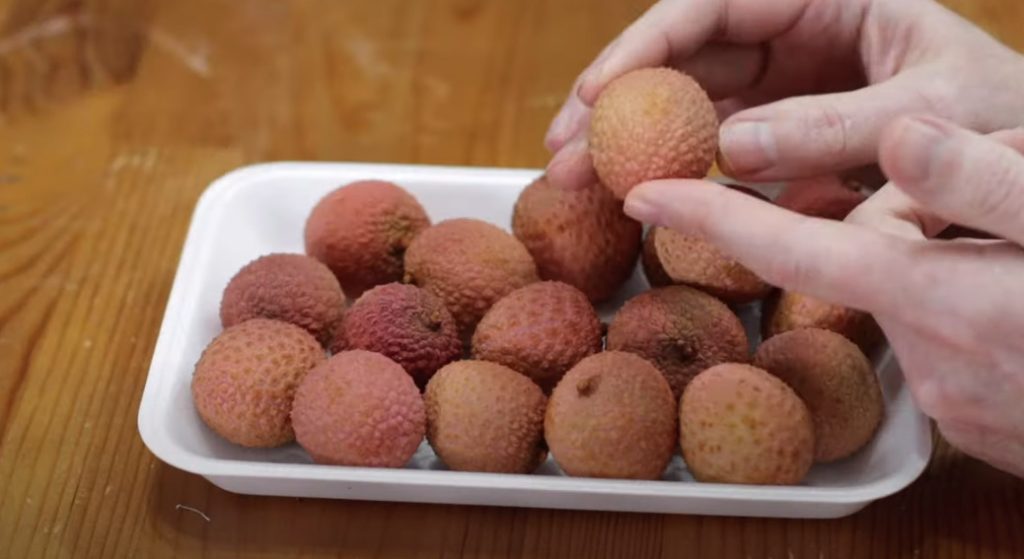Did you know that lychee, also known as litchi or lichi, was once a coveted delicacy exclusive to the Chinese imperial court? This exotic fruit is not only steeped in rich history but also surging in popularity across the globe. In this comprehensive guide, explore everything about the lychee: from its intriguing background and cultural significance to its tantalizing flavor and myriad health benefits. Embrace the journey into the heart of what makes the lychee a gem among tropical fruits.
Key Takeaways
- Discover why lychee was historically considered an exquisite treat of royalty.
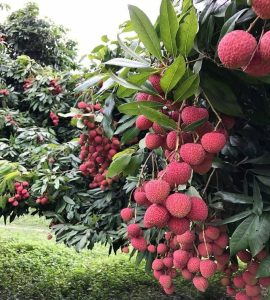
- Unveil the fascinating journey and cultural importance of this beloved tropical fruit.
- Delve into the unique taste profile that has contributed to lychee’s global culinary appeal.
- Learn about the impressive array of health benefits that lychee offers to enthusiasts.
- Gaininsights into the various terms – lychee, litchi, and lichi – that refer to this one of a kind fruit.
Understanding the Lychee: An Introduction
An exquisite gem within the realm of exotic fruits is the lychee, a delectable treat treasured for its sweet, fragrant pulp. To truly appreciate this delightful fruit, a deep dive into its essence, its rich heritage, and the variety it offers is imperative. This section will enrich your knowledge about the lychee fruit, taking you back through the history of the lychee, and unfolding an exploration of its numerous varieties.
What Is Lychee?
The lychee (Litchi chinensis) is a tropical fruit that boasts a rough, red rind encompassing translucent white flesh. Originally from subtropical regions in China, the lychee fruit is cherished for its unique combination of sweet and tart flavors complemented by a floral aroma. Recognized as a symbol of love and romance in Chinese culture, lychees are not only celebrated for their taste but their storied past.
The History of Lychee
Often referred to as the ‘king of fruits,’ the lychee has a storied history that can be traced back to ancient China, flourishing in the provinces of Guangdong and Fujian. From its royal orchard beginnings over 2,000 years ago to the present day, the lychee fruit has traveled beyond its native land, gracing markets and menus around the globe. As a revered element of past emperors’ diets, the lychee’s journey from east to west is a testament to its enduring appeal.
Lychee Varieties
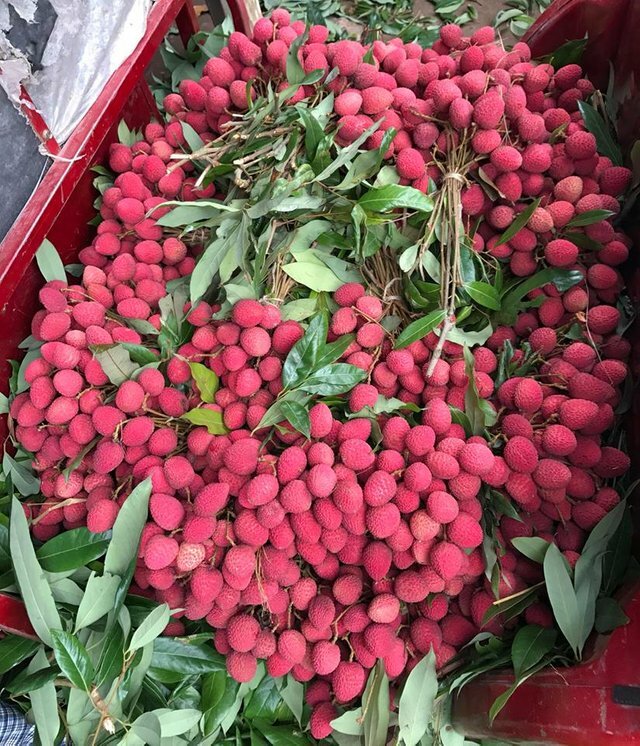
Though many may be accustomed to seeing just one kind of lychee, the fruit exists in a range of cultivars, each with unique characteristics.
| Variety | Flavor Profile | Skin Texture | Seed Size |
|---|---|---|---|
| Brewster | Sweet with a tart finish | Rough, bumpy | Large |
| Mauritius | Delicately sweet | Smooth with small protuberances | Small, often called “chicken tongue” for its shape |
| Haak Yip | Rich and perfumy | Spikey | Small and shriveled |
| Feizixiao | Sweet and aromatic | Bumpy with a sharp apex | Very small, sometimes absent |
Among these, Brewster and Mauritius stand as popular choices in the United States, favored for their balance of sweet and subtle tang, as well as their generous size and juiciness. The introduction to lychee and its varied types showcases the delicious diversity and the rich cultural background embracing this captivating fruit.
The Distinctive Taste of Lychee
Embark on a sensory journey as we delve into the distinctive lychee taste, a palette pleaser known for its unique balance of sweet and tart flavors that captivate the taste buds. Imagine a taste that combines the refreshing sweetness of a grape with the floral subtlety of a rose, complemented by a zesty hint that is evocative of citrus yet singularly its own. This description gets close to answering the perennial question: “What does lychee taste like?” Yet, it can only approximate the experience of tasting the fresh fruit itself.
Typically found in tropical climates, the lychee fruit offers a vibrant tropical flavor that’s a mainstay in many summer dishes and beverages. When you bite into a lychee, you’re greeted by a burst of juicy sweetness followed by a complex profile that deftly walks the line between bold and delicate. The exotic lychee is also known for its perfumed aroma, enhancing its appeal and making it an unforgettable ingredient in both sweet and savory culinary adventures.

- Tartness: The mild acidity provides a counterbalance to the sweetness, ensuring the flavor profile is dynamic, not one-dimensional.
- Sweetness: The lychee’s natural sugars contribute to its overall sweetness, a fundamental characteristic that defines the fruit.
- Floral undertones: Aromatic notes reminiscent of roses or other fragrant blossoms add a unique depth and floral bouquet to the lychee.
- Fragrant aroma: The scent of the lychee is as integral to its flavor as its taste, enriching the overall sensory experience.
In culinary contexts, the distinctive taste of the lychee lends itself exceptionally well to a variety of gastronomic creations. Chefs and mixologists alike celebrate the lychee for its adaptability. Whether incorporated into a refreshing cocktail, a zesty salad, or an indulgent dessert, the lychee imparts a memorable and exotic twist that enhances the dish’s flavor profile.
Indeed, the lychee’s global popularity can be largely attributed to its tantalizing taste, which invites comparisons to other tropical delights yet remains in a league of its own. The next time you encounter this enchanting fruit, take a moment to savor its distinctive taste that has charmed palates the world over.
What Does Lychee Taste Like?
When savoring a lychee, one is immediately struck by its intricate flavor profile, which tantalizes the palate with notes reminiscent of both floral fragrance and fruity zest. To the uninitiated, describing the lychee taste can be as elusive as capturing the essence of a tropical breeze. Yet, for those who have indulged, the lychee offers a sensory voyage through layers of sweet, refreshing, and subtly tart nuances.
To further elucidate the flavor profile of lychee, it’s often likened to a synergy of familiar fruits, yielding comparisons that intrigue and invite trial. A ripe lychee bears a juicy pulp that seamlessly blends the sweetness of grape with the exotic tartness akin to that of a ripe cherry or the zing of citrus notes.
| Comparative Flavor | Lychee Taste Complexity | Notes |
|---|---|---|
| Grape | Sweetness | Fresh, succulent, with a soft, floral finish |
| Cherry | Tartness | A hint of sharpness complementing the sweetness |
| Citrus | Zinginess | Subtle undercurrent of citrus that enlivens the senses |
| Rose | Floral Aroma | Perfumed, aromatic qualities that elevate the fruit’s charm |
When endeavoring to describe the flavor profile of lychee, one must acknowledge its pronounced floral aroma, which often evokes comparisons to roses or other fragrant blossoms. This aromatic quality enhances the fruit’s alluring sweetness and has led to its widespread use in gourmet delicacies and creative mixology.
This refreshing and aromatic nature not only makes the lychee an enjoyable fruit to eat on its own but also contributes to its versatility in recipes and beverages. Be it in a lychee martini, a tropical fruit salad, or a delicate Asian dessert, the lychee’s flavor profile is bold enough to stand out yet nuanced enough to blend harmoniously with other ingredients.
From the sun-soaked orchards to the discerning palate, the lychee’s flavor journey is an adventure of taste, offering a tantalizing blend of sweetness, tang, and aroma that is unmatched in the realm of exotic fruits.
Where Is Lychee From?
The exotic and tantalizing lychee has captivated taste buds around the globe with its fragrant sweetness. But many ponder upon its origins, speculating where is lychee from. Historical evidence places the origin of lychee within the lush, subtropical landscapes of the Guangdong and Fujian provinces in China. It’s here, amid the rich soils and favorable climate, that this jewel of a fruit emerged, flourishing under the care of Chinese farmers for millennia.
In the grand tapestry of history, the lychee’s allure began spreading beyond Chinese borders. To understand the breadth of its journey, looking at a tableau of countries embracing lychee cultivation illuminates how this Chinese native traversed diverse lands, settling in suitable climates that echoed its place of birth.
| Region | Introduction | Cultivation |
|---|---|---|
| India | 18th Century | Extensive, particularly in Bihar |
| Thailand | Early 20th Century | Thriving, with Chiang Mai as a hub |
| South Africa | Late 19th Century | Modest, mainly in subtropical zones |
| Brazil | 19th Century | Concentrated in São Paulo and Minas Gerais |
| United States | Early 20th Century | Limited, primarily in Florida and Hawaii |
| Australia | 19th Century | Expanding, with Queensland as a key producer |
With its ancient beginnings rooted in Chinese history, the lychee tree has indeed found its way across continents, integrating into various tropical and subtropical climates where it can prosper. These regions, each with their unique conditions, now contribute to the global narrative of lychee’s storied past, enriching our menus and orchards with their bountiful crops.
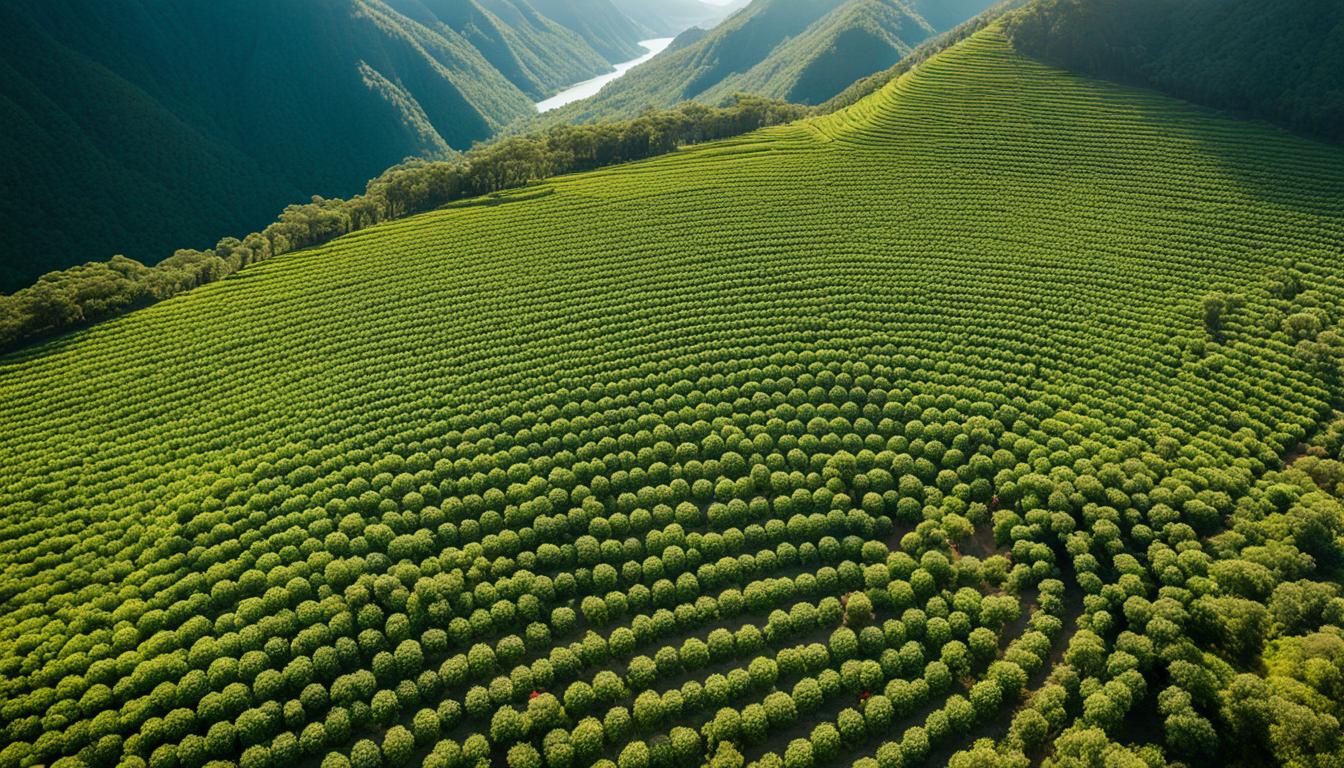
From seed to fruit, the lychee continues to play a significant role in cultural festivities and gastronomic delights, further solidifying its status as a beloved international treasure. Its journey from the heart of China to the far-reaching corners of the world is a testament to the lychee’s enduring legacy and the shared human endeavor to cultivate nature’s sweetness, regardless of the boundaries on a map.
Lychee Nutrition Facts Explained
Delving into the nutritional essence of lychees provides an intriguing glimpse into the health benefits this tropical fruit has to offer. Beyond their unique taste, lychees pack a potent combination of vitamins and minerals, making them not only a delightful treat but also a worthwhile addition to any dietary plan. Here, we unfold the nutritional profile, spotlighting the key nutrients in lychee and the caloric content of lychee, tailored for those who mind their health without compromising on flavor.
Key Nutrients in Lychee
The lychee fruit is a treasure trove of vitamins and minerals, proving itself to be more than just a sweet delight. Every bite offers a burst of vitamin C, significant for immune defense, as well as B-complex vitamins including niacin, thiamin, and folate which support metabolic processes. Minerals such as potassium, copper, phosphorus, and magnesium found within contribute to maintaining the body’s physiological balance.
Caloric Content and Serving Size
When it comes to integrating lychee into a balanced diet, understanding its caloric content is essential. A serving of lychee, which is approximately 100 grams or about four fruits, typically contains a light caloric load, making it an ideal choice for those monitoring their energy intake.
The following table provides a comprehensive breakdown of the nutritional content per standard serving of lychee, illustrating why this exotic fruit is esteemed not only for its exceptional flavor but also for its dietary benefits.
| Nutrient | Amount per 100g Serving |
|---|---|
| Calories | 66 kcal |
| Total Fat | 0.44 g |
| Cholesterol | 0 mg |
| Sodium | 1 mg |
| Total Carbohydrates | 16.53 g |
| Dietary Fiber | 1.3 g |
| Sugars | 15.23 g |
| Protein | 0.83 g |
| Vitamin C | 71.5 mg |
| Vitamin B6 | 0.1 mg |
| Niacin | 0.603 mg |
| Folate | 14 µg |
| Potassium | 171 mg |
| Calcium | 5 mg |
| Magnesium | 10 mg |
| Phosphorus | 31 mg |
| Iron | 0.31 mg |
| Copper | 0.148 mg |
Health Benefits of Lychee
The sweet and succulent lychee is not only a delight for the taste buds but also a powerhouse of health benefits. Integrating lychee into your diet can contribute to a range of positive health outcomes. Below, we delve into how the properties of this exotic fruit can impact well-being.
Antioxidant Properties
Rich in vitamin C and flavonoids, lychees boast impressive antioxidant properties. Antioxidants are crucial for neutralizing harmful free radicals in the body, which can lead to cellular damage and contribute to chronic diseases. Regular consumption of lychee can therefore aid in the prevention of oxidative stress, boosting overall health.
Cardiovascular Health and Lychee
Lychees contain oligonol, a compound known for improving blood flow and reducing weight, which has direct implications for cardiovascular health. With its anti-inflammatory properties, oligonol also helps in reducing the risk of heart disease by preventing the build-up of platelets and improving lipid profiles.
Lychee and Weight Management
Low in calories yet high in dietary fiber, lychees can be a valuable addition to a weight management regime. The fiber content helps promote satiety, reducing the overall calorie intake, while the sweet taste satisfies sugar cravings in a healthy manner. Here’s a quick glance at the potential health impacts:
| Health Aspect | Benefit |
|---|---|
| Antioxidant Capacity | Fights oxidative stress and reduces disease risk |
| Heart Health | Improves blood circulation and lipid profile |
| Weight Management | Low-calorie profile and fiber aids in reducing appetite |
How to Eat Lychee

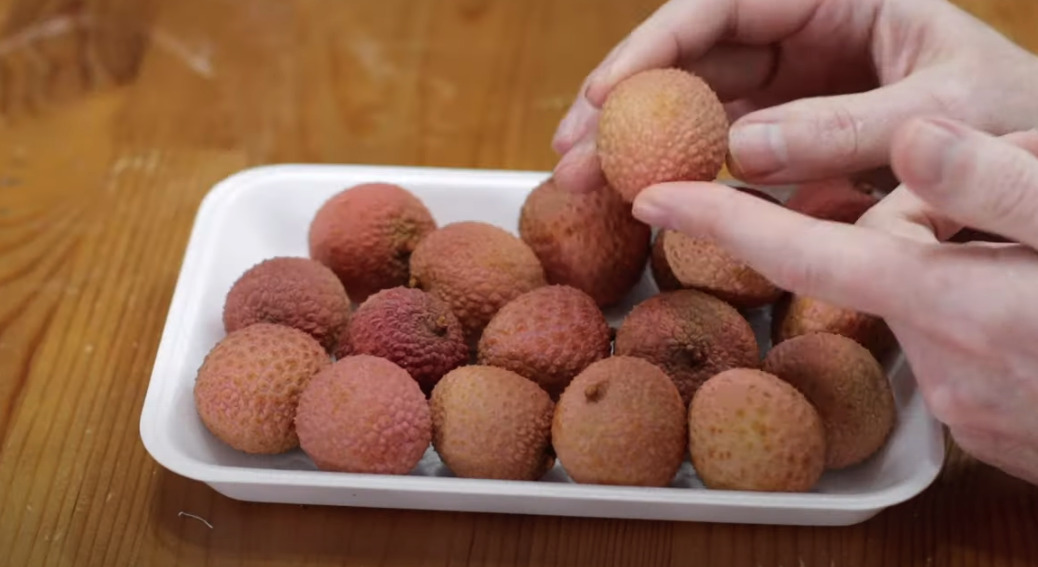
Discovering the delicate taste of lychee begins with understanding the proper way of preparing this tropical delight. Once you know how to eat lychee, you’ll be able to enhance your diet with its sweet, fragrant flavor. Preparing lychee and incorporating it into your daily meals and snacks offers a refreshing change to your culinary routine.
Preparing Lychee for Consumption
To enjoy lychee’s luscious taste, the fruit must be prepped correctly. Through straightforward steps, preparing lychee becomes effortless:
- Wash the lychee under cool, running water.
- Peel off the rough outer skin to reveal the translucent flesh.
- Remove the large seed in the center to make the fruit ready to eat.
Once the lychee is peeled and deseeded, it can be savored fresh or added to various dishes.
Creative Ways to Include Lychee in Your Diet
Incorporating lychee into your diet can be an exciting culinary adventure. Here’s a table of creative suggestions:
| Meal | Idea | Preparation Tip |
|---|---|---|
| Breakfast | Lychee Yogurt Parfait | Layer Greek yogurt with lychee, granola, and a drizzle of honey. |
| Lunch | Lychee Chicken Salad | Toss diced lychee with chicken, mixed greens, and a light vinaigrette. |
| Dinner | Pork and Lychee Stir Fry | Stir fry pork strips with lychee and vegetables, serve with rice. |
| Dessert | Lychee Sorbet | Blend lychee into a puree, add sugar to taste, then freeze until set. |
| Beverage | Lychee Martini | Mix lychee juice with vodka and a splash of vermouth, serve chilled. |
Whether enjoying lychee as a snack or as part of a meal, its sweet aroma adds a dash of the exotic to your diet.
How to Pronounce Lychee
Embarking on the journey of discovering exotic fruits often begins with learning the correct way to articulate their names. This holds true for the lychee, a tropical delight that often sees its name rolled off the tongues of fruit aficionados in various, sometimes contrasting, ways. How to pronounce lychee is a question that surfaces frequently, given the fruit’s global popularity.
To aid in demystifying this pronunciation puzzle, we present a comparison of common phonetic renditions used in different languages and locales.
| Region/Language | Phonetic Pronunciation | Notes |
|---|---|---|
| American English | LEE-chee | Emphasis on the first syllable, the ‘y’ is silent. |
| British English | LYE-chee | “Ly” rhymes with “rye”; ‘y’ is pronounced. |
| Cantonese | LAI-ji | Closer to the original Chinese pronunciation. |
| Mandarin | LEE-jee | Similar to Cantonese but with a softer ‘j’ sound. |
Whether you prefer the American LEE-chee or the British LYE-chee, knowing how to pronounce lychee correctly ensures you can confidently discuss this sumptuous fruit with fellow enthusiasts. Moreover, understanding the nuances in pronunciation enriches the cultural tapestry woven around this beloved fruit.
Next time you find yourself at a fruit market or a discussion about exotic fruits, you can shine in conversation with your impeccable pronunciation of lychee. Not only does how to pronounce lychee roll off the tongue easily now, but having this knowledge also invites you to savor every syllable analogous to savoring the fruit’s sweet, aromatic flavor.
Where to Find Lychee
Finding fresh lychee can turn into an exciting adventure for fruit enthusiasts looking to indulge in the sweet-tart taste of this tropical delicacy. While lychee is not as ubiquitous as apples or bananas on supermarket shelves, there are certain places where you can expect a bounty of these exotic fruits, particularly when they’re in season. This section will steer you through the realms of local markets and specialty retailers, ensuring you come home with the freshest lychee available.
Shopping for Fresh Lychee

When you’re on the hunt for fresh lychee, your best bet is to visit local farmers’ markets or Asian grocery stores. These outlets often carry exotic fruits and are more likely to stock fresh produce directly from growers. Keep an eye out during the lychee season, which peaks during the warmer months, as this is when you’ll find them at their freshest. Some health food stores and upscale grocers might also offer lychee, so don’t forget to check these establishments during your search.
Identifying Ripe Lychee
Picking out ripe lychee is key to enjoying its full flavor profile. Ripe lychees are usually a vibrant red or pink, with a slightly rough skin texture that indicates maturity. They should feel firm but give slightly under pressure, signaling the presence of juicy, ready-to-eat flesh inside. Avoid any fruits with brown spots or those that appear dry or shriveled, as these are signs of overripeness or staleness. Trust your senses: a fragrant, floral aroma is a promising indicator of a ripe lychee ready to be savored.
- Search for a bright red or pink color
- Choose lychees with a bumpy, leathery skin
- Select fruits that are firm with a slight give
- Confirm by smelling for a sweet and floral fragrance
Whether you’re shopping for fresh lychee or identifying ripe lychee, remember that quality is paramount. These tips will help ensure you bring home the finest lychee, bursting with the delightful flavors you crave. So embark on your quest, keeping these suggestions in mind, and relish the delectable experience that fresh lychee has to offer.
When Is Lychee Season?
The eagerly awaited lychee season typically peaks in a beacon of tropical deliciousness from May to July. Known for its limited annual debut, understanding when is lychee season is crucial for aficionados of this exotic fruit seeking the utmost freshness and quality. Variations in regional climates and agricultural practices play a critical role in availability, dictating the brief but splendid window when lychees reach market stands.
Depending on your geographic location, the lychee season may slightly vary. Here is a succinct overview of what to expect:
| Region | Season Start | Season End | Peak Harvest |
|---|---|---|---|
| Florida, USA | Early May | Mid July | June |
| California, USA | Late May | Late July | Early July |
| Hawaii, USA | May | August | June – July |
| Australia | Late October | Mid January | November – December |
| India | April | June | May |
| China | May | July | June |
Whether you’re planning to indulge in their sweet delicacy, or perhaps incorporate them into culinary endeavors, timing your purchase during lychee season is key. The limited seasonal window ensures you enjoy the freshest, juiciest lychees that nature has to offer. Keep this seasonal guide handy to make the most of this year’s harvest!
How to Store Lychee
Savoring the tropical delight of lychee begins with understanding how to store lychee properly to maintain its freshness. Whether you’re looking to enjoy these exotic fruits in the immediate future or wish to preserve their juicy texture for later, these storage tips will ensure that your lychees remain in peak condition.
Refrigeration is key when it comes to extending the shelf life of fresh lychees. If you’re planning to eat your lychees within a week, following this method will keep them ripe and ready for consumption:
- Place unwashed lychees in a perforated plastic bag to allow for air circulation.
- Store the bag of lychees in the crisper drawer of your refrigerator.
- Use within 5-7 days for optimum freshness.
For those looking to enjoy their lychee stash over a period of time, freezing offers an excellent solution:
- Peel the lychees and remove the seeds, keeping only the succulent flesh.
- Arrange the lychee segments in a single layer on a baking sheet, ensuring none are touching.
- Freeze until the segments are solid to prevent them from clumping together.
- Transfer frozen lychee segments to airtight containers or freezer bags.
- Lychees can be frozen for up to 6 months. Thaw in the refrigerator before eating or using in recipes.
Canning is another alternative for long-term preservation:
- Prepare a mixture of sugar and water to create a syrup.
- Pack peeled and pitted lychees into canning jars, and cover with the cooled syrup.
- Process in a water bath canner for the time specified for your altitude and jar size.
- Once canned, store in a cool, dark place and consume within a year for best quality.
Remember: Prior to consuming stored lychees, inspect them for any signs of spoilage such as discoloration or off odors and dispose of any that do not meet quality standards.
| Storage Method | Preparation | Shelf Life |
|---|---|---|
| Refrigeration | Unwashed in perforated bag | 5-7 days |
| Freezing | Peeled and pitted on baking sheet, then transferred to containers | Up to 6 months |
| Canning | Peeled and pitted, covered in syrup | Up to 1 year |
By adhering to these practices, you can enjoy the exquisite flavor of lychee no matter the season. Incorporating these methods into your fruit preservation routine will not only save you time and money but also provide you with a delicious, refreshing fruit option year-round.
How to Grow Lychee from Seed
Growing a lychee tree from seed can be a rewarding project for gardeners looking to cultivate their own exotic fruit trees. While it requires patience and attention to detail, the process of planting lychee seeds and maintaining the emerging tree can be a fascinating journey into the world of tropical horticulture.
Step by Step: Planting Lychee Seeds
To initiate your lychee cultivation, selecting healthy, ripe lychees is crucial as they yield the best seeds. When planting lychee seeds, it’s important to plant them promptly, as their viability decreases significantly with time. Here’s how to get started:
- Extract the Seed: Remove the seed from the fruit and clean it thoroughly.
- Seed Preparation: Soak the seed in water for a day to expedite the germination process.
- Select the Right Soil: Prepare a pot with well-draining, fertile soil. A mix of peat, sand, and perlite is recommended for optimal growth.
- Sowing the Seed: Plant the seed about an inch deep in the soil and water it gently.
- Provide Adequate Warmth: Place the pot in a warm area but out of direct sunlight. Consistent warmth is a catalyst for germination.
- Regular Monitoring: Keep the soil moist but not soggy to prevent rot. Watch for sprouting, which may occur within a few weeks.
Maintaining Your Lychee Tree for Optimal Growth
Once your lychee has sprouted and begins to grow, ongoing care is pivotal for the development of a healthy tree that will eventually bear fruit. Consider these maintenance tips:
- Lighting: Lychee saplings enjoy bright, indirect sunlight. Gradually acclimate your tree to more direct sunlight as it matures.
- Watering: Maintain moisture in the soil without overwatering. As the tree grows, it will need less frequent but deeper watering.
- Fertilization: Use a balanced, slow-release fertilizer to provide necessary nutrients without burning the roots.
- Potting: Repotting may be necessary as the tree grows. Ensure you’re using a large pot with proper drainage to accommodate the root system.
- Pest Management: Watch for signs of pests or diseases and treat promptly to avoid damage to the young tree.
- Pruning: Prune the tree to encourage a strong structure and remove any dead or diseased branches.
Remember, it can take several years for a lychee tree grown from seed to produce fruit, so patience is essential. With the right conditions, your efforts in planting lychee seeds and diligently maintaining the lychee tree will be rewarded with the unique pleasure of harvesting your own, home-grown lychees.
How to Pick Lychee

Understanding how to pick lychee is essential for enjoying the peak flavors of this exotic fruit. Whether you’re browsing through a market or fortunate enough to have access to a lychee tree, knowing the signs of a ripe lychee can elevate your fruit experience.
When looking for ready-to-eat lychee, appearance and texture are your reliable indicators. A ripe lychee usually has a bright red or pink-red skin, though some varieties may have a slight orange hue. The skin, though bumpy, should be firm yet give slightly under gentle pressure. If it’s hard, the lychee is not yet ripe; if too soft, it may be overripe.
| Indicator | Significance | Desired Condition |
|---|---|---|
| Color | Skins that are brown or green may indicate under-ripeness or overripeness, respectively. | Bright red to pink-red, occasionally with a slight orange cast |
| Texture | The feel of the skin can indicate the freshness and ripeness of the fruit. | Firm with a slight give when pressed |
| Aroma | A ripe lychee emits a fragrant scent which can be a reliable indicator of readiness. | Sweet and floral, easily noticeable upon close inspection |
| Feel | Fruits that are too firm or too spongy may not provide the optimal taste experience. | Yielding slightly under pressure, it should not be mushy |
Besides visual and tactile cues, aroma is another crucial factor. A ripe lychee will release a sweet and intoxicating fragrance. If the fruit lacks scent, it’s likely not ready to be savored. In a store, refrain from purchasing lychees that are cracked or leaking—these fruits might have begun to spoil. For the freshest consumption, use this knowledge to guide your purchase and partake in the delightful taste and healthful benefits of lychee.
Choosing lychee with these factors in mind ensures a delightful combination of sweet and tart flavors complemented by a subtle floral scent that lychee lovers seek out.
By keeping these tips on how to pick lychee in mind, you can confidently select the finest lychees for your next culinary adventure or wholesome snack.
Lychee Recipes and What to Make with Lychee
With its exotic and alluring taste, lychee stands out as a unique ingredient that can transform both beverages and dishes. Its versatility in the culinary world is boundless, and for those wondering what to make with lychee, the possibilities are as refreshing as they are delectable. In this section, we will explore a range of lychee recipes that celebrate this fruit’s delightful fusion of sweetness and tartness—perfect for those eager to introduce a tropical twist to their cuisine.
Refreshing Lychee Beverages
When it comes to crafting lychee beverages, the fruit’s juicy and floral notes make for an invigorating addition. A simple yet sophisticated option is a lychee martini, blending the fruit’s puree with a splash of vodka and a hint of vermouth, garnished with a whole lychee for an elegant finish. For non-alcoholic choices, a lychee iced tea or sparkling lychee lemonade offers a rejuvenating respite from the heat, making these drinks summer staples for all ages. These concoctions not only quench thirst but also serve as conversation-starting centerpieces for any gathering.
Sweet and Savory Lychee Dishes
Turning to the kitchen, lychee recipes extend well beyond drinks; they are equally impressive in both sweet and savory lychee dishes. Imagine a tropical salad where lychee’s succulence complements the textures of avocado and shrimp, drizzled with a zesty lime dressing. Or envision a lychee sorbet, its natural sweetness heightened with a touch of honey, offering a light yet luscious dessert option. In entrées, lychee can be used to create a fruity glaze for pork or duck, marrying beautifully with rich meats and adding a layer of complexity to the flavors. These lychee-inspired recipes are not merely meals but experiences that evoke the senses.
FAQ
Q: What Is Lychee?
A: Lychee, also known as litchi or lichi, is a tropical fruit known for its sweet and fragrant flavor profile. It has a rough, leathery red skin and juicy, translucent flesh, which is typically eaten fresh but can also be found canned or dried.
Q: What Does Lychee Taste Like?
A: Lychee has a distinctive taste that balances sweetness and tartness, often described as a mix between a grape and a pear with a hint of rosewater or floral notes – a refreshing and aromatic flavor that makes it unique among tropical fruits.
Q: Where Is Lychee From?
A: Lychee originates from the Guangdong and Fujian provinces of China and has been cultivated for more than 2,000 years. It has since spread around the world, particularly across tropical and subtropical regions.
Q: What Are the Key Nutrients in Lychee?
A: Lychee is rich in vitamins and minerals like vitamin C, potassium, and copper. It also contains antioxidants, dietary fiber, and a balance of other vitamins like B6, niacin, riboflavin, and folate.
Q: What Are the Health Benefits of Lychee?
A: The potent antioxidants in lychee support the fight against oxidative stress. The fruit may also contribute to cardiovascular health due to its potassium content and help with weight management due to its low-calorie profile and fiber content.
Q: How Must One Eat Lychee?
A: To eat lychee, peel off the rough skin to reveal the juicy flesh inside. Remove the large seed, and enjoy the fruit fresh. Remember, the skin and seed are not edible.
Q: How Can You Pronounce Lychee Correctly?
A: The pronunciation of lychee varies, but in American English, it is commonly pronounced as “LEE-chee.”
Q: Where Can You Find Lychee?
A: Lychee can be found at farmers’ markets, Asian specialty stores, and some supermarkets, especially during its season, which runs from May to July in the northern hemisphere.
Q: When Is Lychee Season?
A: The lychee season typically peaks from May to July in countries in the northern hemisphere. However, the exact timing can shift based on geographic location and climate.
Q: How Should Lychee Be Stored?
A: Fresh lychees should be stored in a plastic bag in the refrigerator, where they can last for up to a week. For longer preservation, lychees can be peeled, deseeded, and frozen.
Q: How Do You Grow Lychee from Seed?
A: To grow lychee from seed, plant fresh seeds in well-draining soil, keep the soil moist, and provide warm conditions with partial shade. Be patient, as it may take several years for the plant to bear fruit.
Q: How Do You Pick the Best Lychee?
A: Look for lychees that have vibrant red skin, which is firm yet bumpy to the touch. The fruit should feel heavy for its size, indicating juiciness. Avoid lychees with brown spots or those that are too soft.
Q: What Can You Make with Lychee?
A: Lychee can be utilized in a myriad of recipes, including refreshing beverages like cocktails and smoothies, and sweet or savory dishes like salads, seafood entrees, and desserts such as ice creams and sorbets.

